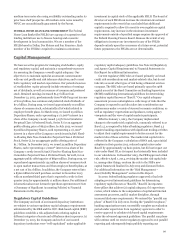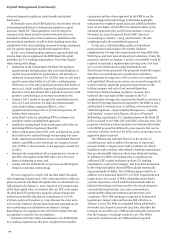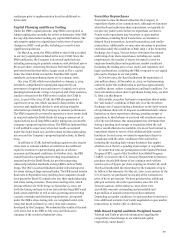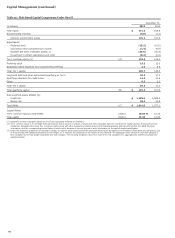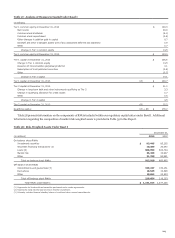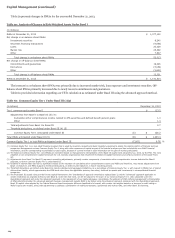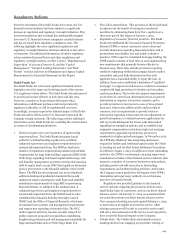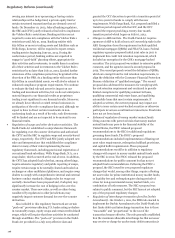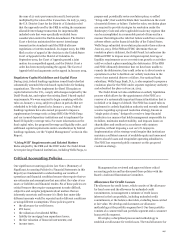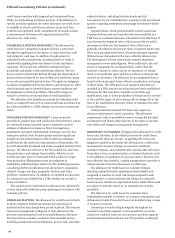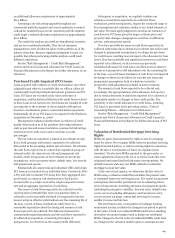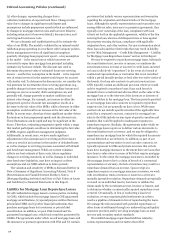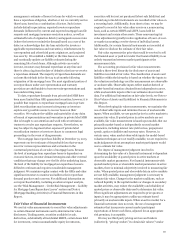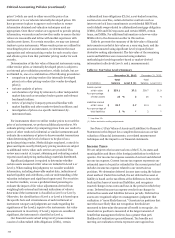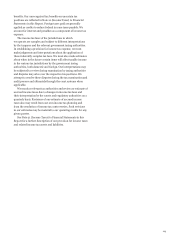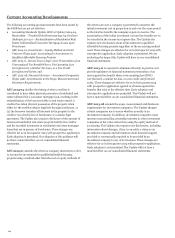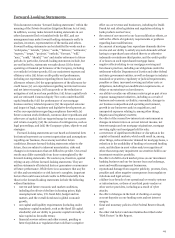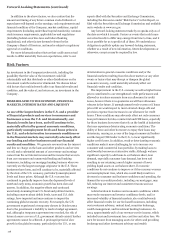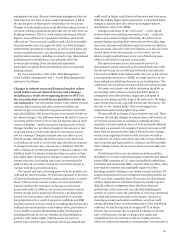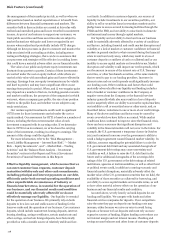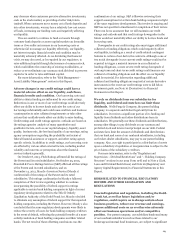Wells Fargo 2013 Annual Report Download - page 111
Download and view the complete annual report
Please find page 111 of the 2013 Wells Fargo annual report below. You can navigate through the pages in the report by either clicking on the pages listed below, or by using the keyword search tool below to find specific information within the annual report.an additional allowance requirement of approximately
$8.4 billion.
Assuming a one risk rating upgrade throughout our
commercial portfolio segment and a more optimistic economic
outlook for modeled losses on our consumer portfolio segment
could imply a reduced allowance requirement of approximately
$2.0 billion.
The sensitivity analyses provided are hypothetical scenarios
and are not considered probable. They do not represent
management’s view of inherent losses in the portfolio as of the
balance sheet date. Because significant judgment is used, it is
possible that others performing similar analyses could reach
different conclusions.
See the “Risk Management – Credit Risk Management”
section and Note 6 (Loans and Allowance for Credit Losses) to
Financial Statements in this Report for further discussion of our
allowance.
Purchased Credit-Impaired (PCI) Loans
Loans acquired with evidence of credit deterioration since their
origination and where it is probable that we will not collect all
contractually required principal and interest payments are PCI
loans. PCI loans are recorded at fair value at the date of
acquisition, and the historical allowance for credit losses related
to these loans is not carried over. Such loans are considered to be
accruing due to the existence of the accretable yield and not
based on consideration given to contractual interest payments.
Substantially all of our PCI loans were acquired in the Wachovia
acquisition on December 31, 2008.
Management evaluates whether there is evidence of credit
quality deterioration as of the purchase date using indicators
such as past due and nonaccrual status, commercial risk ratings,
recent borrower credit scores and recent loan-to-value
percentages.
The fair value at acquisition is based on an estimate of cash
flows, both principal and interest, expected to be collected,
discounted at the prevailing market rate of interest. We estimate
the cash flows expected to be collected at acquisition using our
internal credit risk, interest rate risk and prepayment risk
models, which incorporate our best estimate of current key
assumptions, such as property values, default rates, loss severity
and prepayment speeds.
Substantially all commercial and industrial, CRE and foreign
PCI loans are accounted for as individual loans. Conversely, Pick-
a-Pay and other consumer PCI loans have been aggregated into
pools based on common risk characteristics. Each pool is
accounted for as a single asset with a single composite interest
rate and an aggregate expectation of cash flows.
The excess of cash flows expected to be collected over the
carrying value (estimated fair value at acquisition date) is
referred to as the accretable yield and is recognized in interest
income using an effective yield method over the remaining life of
the loan, or pool of loans, in situations where there is a
reasonable expectation about the timing and amount of cash
flows expected to be collected. The difference between the
contractually required payments and the cash flows expected to
be collected at acquisition, considering the impact of
prepayments, is referred to as the nonaccretable difference.
Subsequent to acquisition, we regularly evaluate our
estimates of cash flows expected to be collected. These
evaluations, performed quarterly, require the continued usage of
key assumptions and estimates, similar to our initial estimate of
fair value. We must apply judgment to develop our estimates of
cash flows for PCI loans given the impact of home price and
property value changes, changing loss severities, modification
activity, and prepayment speeds.
If we have probable decreases in cash flows expected to be
collected (other than due to decreases in interest rate indices and
changes in prepayment assumptions), we charge the provision
for credit losses, resulting in an increase to the allowance for loan
losses. If we have probable and significant increases in cash flows
expected to be collected, we first reverse any previously
established allowance for loan losses and then increase interest
income as a prospective yield adjustment over the remaining life
of the loan, or pool of loans. Estimates of cash flows are impacted
by changes in interest rate indices for variable rate loans and
prepayment assumptions, both of which are treated as
prospective yield adjustments included in interest income.
The amount of cash flows expected to be collected and,
accordingly, the appropriateness of the allowance for loan loss
due to certain decreases in cash flows expected to be collected, is
particularly sensitive to changes in loan credit quality. The
sensitivity of the overall allowance for credit losses, including
PCI loans, is presented in the preceding section, “Critical
Accounting Policies – Allowance for Credit Losses.”
See the “Risk Management – Credit Risk Management”
section and Note 6 (Loans and Allowance for Credit Losses) to
Financial Statements in this Report for further discussion of PCI
loans.
Valuation of Residential Mortgage Servicing
Rights
MSRs are assets that represent the rights to service mortgage
loans for others. We recognize MSRs when we purchase servicing
rights from third parties, or retain servicing rights in connection
with the sale or securitization of loans we originate (asset
transfers). We also have MSRs acquired in the past under co-
issuer agreements that provide for us to service loans that were
originated and securitized by third-party correspondents. We
initially measure and carry our MSRs related to residential
mortgage loans at fair value.
At the end of each quarter, we determine the fair value of
MSRs using a valuation model that calculates the present value
of estimated future net servicing income. The model incorporates
assumptions that market participants use in estimating future
net servicing income, including estimates of prepayment speeds
(including housing price volatility), discount rates, default rates,
cost to service (including delinquency and foreclosure costs),
escrow account earnings, contractual servicing fee income,
ancillary income and late fees.
Net servicing income, a component of mortgage banking
noninterest income, includes the changes from period to period
in fair value of both our residential MSRs and the free-standing
derivatives (economic hedges) used to hedge our residential
MSRs. Changes in the fair value of residential MSRs result from
(1) changes in the valuation model inputs or assumptions and
109


